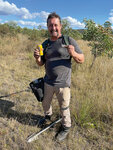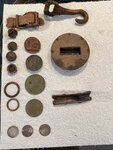


Fred Wimmer and Chris Stephensen were recently out in the Australian bush on a metal detecting trip when they came across a dog tag with the name of Thomas F. Jenkins, from Battle Ground.
Wimmer found the dog tag some 7,315 miles away from North Clark County and they are now working to find relatives of Jenkins, so they can return the piece of history.
The duo was searching in the area of the former location of Camp Cable during World War II, which once housed the U.S. 32nd “Red Arrow” Division, along with other units and soldiers from Australia and New Zealand, according to the Queensland government website.
“I want to find the relatives. It’s one of those things, like I love metal detecting. I love finding all the trinkets and stuff. It’s pretty cool,” Wimmer said. “I think when you find something like that, well, a lot of people just keep (the dog tags), but it really belongs with the family.”
The relatives of Jenkins may no longer live in the Clark County area. An obituary in The Columbian from 1971 for Jenkins’ mother, Bessie, listed her being survived by her son, Thomas F. Jenkins, of San Clemente, California. That information is enough proof that Jenkins survived WWII despite his dog tag being located in Australia.
The obituary also states that Bessie Jenkins was survived by six grandchildren and 14 great-grandchildren, between Thomas F. Jenkins and his sister Thelma L. Karr, who lived in Eugene, Oregon at that time.
According to the Queensland government website, “Camp Cable was built as a training base for the U.S. 32nd ‘Red Arrow’ Infantry Division, which was sent to Australia in return for the Australian 9th Division remaining in the Middle East. Most of Camp Cable was constructed between July and October 1942 by private contractors employed by the Allied Works council. The camp was handed over to the Australian Army in August 1944.”
The website states the 32nd Red Arrow Infantry Division was formed from National Guard units from Michigan and Wisconsin. Main elements of the division included three infantry regiments — 126th, 127th and 128th — and four field artillery battalions: 120th, 121st, 126th and 129th. The camp also included a military police company, the 114th engineer battalion that replaced the 107th engineer battalion, the 10th medical battalion, the 107th quartermaster battalion, the 32nd signal company, the 32nd cavalry reconnaissance troop and the 632nd tank destroyer battalion.
Wimmer and Stephensen recently made a Facebook post in the “Battle Ground, WA” group to ask for the community’s help to bring the dog tag home, but as of last week, were unsuccessful.
“I would like to find the family of Thomas F. Jenkins,” Wimmer said. “If we can find whoever his next of kin is and get the tag back to them.”
This isn’t the first dog tag Australian residents Wimmer and Stephensen have found near the site of Camp Cable, which is located near Brisbane, Australia. Wimmer previously found two dog tags that were sent to surviving relatives in Michigan with the help of Australia’s show “A Current Affair,” hosted by Ally Langdon. Langdon is an Australian television presenter, reporter, journalist and author.
Wimmer took on the hobby of metal detecting in Australia to keep busy when the weather isn’t the best for water activities, like jet skiing. Stephenson showed him the “secret spot” where they often go metal detecting.
The duo gives each other credit for locating the dog tag, but it was Wimmer’s detector and shovel that uncovered the lost artifact of history.
Anyone with information on Jenkins or his relatives can contact The Reflector by email at news@thereflector.com or by phone at 360-687-5151. The Reflector will pass on the information to Wimmer and Stephensen.